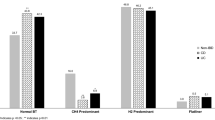Abstract
Background
Understanding intestinal gases volume and composition may contribute to diagnosing digestive diseases and the microbiome's status. This meta-analysis aimed to define the composition of human intestinal gases and changes associated with diet.
Methods
Studies were identified by systematic research of the MEDLINE(Ovid), Scopus, and Cochrane databases. Studies that measured the concentration of intestinal gases in healthy adult humans were retrieved. The JBI critical appraisal tool was used to evaluate the risk of bias. The primary outcomes analysed were the concentration of the most prevalent colonic gases. Participants were divided into groups according to dietary fibre content.
Results
Eleven studies were included. The following gases were identified in similar concentrations across all studies (mean ± standard deviation): nitrogen (65.1 ± 20.89%), oxygen (2.3 ± 0.98%), carbon dioxide (9.9 ± 1.6%), hydrogen (2.9 ± 0.7%), and methane (14.4 ± 3.7%). Differences according to the dietary fibre were observed, with a positive correlation between fibre and volume of gas produced, particularly in fermented gases (carbon dioxide, hydrogen, and methane).
Discussion
The meta-analysis has found defined concentrations of the five most common gases present in human colonic gas. Limitations included heterogenic methodologies, a low number of participants, and few recent studies. These findings may be helpful in diagnostic applications where colonic gas volume and composition are crucial factors, including functional disorders, microbiome analyses, and bowel perforation diagnostics.












Similar content being viewed by others
Abbreviations
- CO2 :
-
Carbon dioxide
- CH4 :
-
Methane
- GC:
-
Gas chromatography
- H2 :
-
Hydrogen
- H2S:
-
Hydrogen sulphide
- IBS:
-
Irritable bowel syndrome
- N2 :
-
Nitrogen
- O2 :
-
Oxygen
- PPM:
-
Parts per million
- SRB:
-
Sulphate-reducing bacteria
References
King TS, Elia M, Hunter JO. Abnormal colonic fermentation in irritable bowel syndrome. Lancet. 1998;352:1187–1189.
Espey MG. Role of oxygen gradients in shaping redox relationships between the human intestine and its microbiota. Free Radic Biol Med. 2013;55:130–140.
Major G, Pritchard S, Murray K, Alappadan JP, Hoad CL, Marciani L et al. Colon hypersensitivity to distension, rather than excessive gas production, produces carbohydrate-related symptoms in individuals with irritable bowel syndrome. Gastroenterology. 2017;152:124–133.
Rumessen JJ, Gudmandhøyer E. Functional bowel-disease: malabsorption and abdominal distress after ingestion of fructose, sorbitol, and fructose-sorbitol mixtures. Gastroenterology. 1988;95:694–700.
Shin W. Medical applications of breath hydrogen measurements. Anal Bioanal Chem. 2014;406:3931–3939.
Ong DK, Mitchell SB, Barrett JS, Shepherd SJ, Irving PM, Biesiekierski JR et al. Manipulation of dietary short chain carbohydrates alters the pattern of gas production and genesis of symptoms in irritable bowel syndrome. J Gastroenterol Hepatol. 2010;25:1366–1373.
Calloway DH, Murphy EL. The use of expired air to measure intestinal gas formation. Ann NY Acad Sci. 1968;150:82–95.
Murphy EL, Calloway DH. The effect of antibiotic drugs on the volume and composition of intestinal gas from beans. Am J Dig Dis. 1972;17:639–642.
Steggerda FR. Gastrointestinal gas following food consumption. Ann NY Acad Sci. 1968;150:57–66.
Suarez F, Furne J, Springfield J, Levitt M. Insights into human colonic physiology obtained from the study of flatus composition. Am J Physiol. 1997;272:G1028-1033.
Tomlin J, Lowis C, Read NW. Investigation of normal flatus production in healthy volunteers. Gut. 1991;32:665–669.
Wagner JR, Carson JF, Becker R, Gumbmann MR, Danhof IE. Comparative flatulence activity of beans and bean fractions for man and the rat. J Nutrit. 1977;107:680–689.
David LA, Maurice CF, Carmody RN, Gootenberg DB, Button JE, Wolfe BE et al. Diet rapidly and reproducibly alters the human gut microbiome. Nature. 2014;505:559–563.
Iweala OI, Nagler CR. Immune privilege in the gut: the establishment and maintenance of non-responsiveness to dietary antigens and commensal flora. Immunol Rev. 2006;213:82–100.
Wynne EK, Azagury DE. Novel device to detect enterotomies in real time during laparoscopy: first in human trial during Roux-en-y gastric bypass. Surg Endosc. 2019;33:1687–1692.
Kirk E. The quantity and composition of human colonic flatus. Gastroenterology. 1949;12:782–794.
Calloway DH, Hickey CA, Murphy EL. Reduction of intestinal gas-forming properties of legumes by traditional and experimental food processing methods. J Food Sci. 1971;36:251–255.
Levitt MD. Volume and composition of human intestinal gas determined by means of an intestinal washout technic. N Engl J Med. 1971;284:1394–1398.
Marthinsen D, Fleming SE. Excretion of breath and flatus gases by humans consuming high-fiber diets. J Nutrit. 1982;112:1133–1143.
Kalantar-Zadeh K, Berean KJ, Ha N, Chrimes AF, Xu K, Grando D et al. A human pilot trial of ingestible electronic capsules capable of sensing different gases in the gut. Nat Elect. 2018;1:79–87.
Levitt MD, Bond JH Jr. Volume, composition, and source of intestinal gas. Gastroenterology. 1970;59:921–929.
Levitt MD. Intestinal gas. Postgrad Med. 1975;57:77–81.
Scaldaferri F, Nardone O, Lopetuso LR, Petito V, Bibbò S, Laterza L et al. Intestinal gas production and gastrointestinal symptoms: from pathogenesis to clinical implication. Eur Rev Med Pharmacol Sci. 2013;17:2–10.
Carbonero F, Benefiel AC, Gaskins HR. Contributions of the microbial hydrogen economy to colonic homeostasis. Nat Rev Gastroenterol Hepatol. 2012;9:504–518.
Linden DR. Hydrogen sulfide signaling in the gastrointestinal tract. Antioxid Redox Signal. 2014;20:818–830.
Guidotti TL. Hydrogen sulfide intoxication. Handb Clin Neurol. 2015;131:111–133.
Suarez FL, Springfield J, Levitt MD. Identification of gases responsible for the odour of human flatus and evaluation of a device purported to reduce this odour. Gut. 1998;43:100–104.
Gibson GR, Macfarlane GT, Cummings JH. Sulphate reducing bacteria and hydrogen metabolism in the human large intestine. Gut. 1993;34:437–439.
Perez F, Accarino A, Azpiroz F, Quiroga S, Malagelada JR. Gas distribution within the human gut: effect of meals. Am J Gastroenterol. 2007;102:842–849.
Harder H, Serra J, Azpiroz F, Passos MC, Aguade S, Malagelada JR. Intestinal gas distribution determines abdominal symptoms. Gut. 2003;52:1708–1713.
Saltzberg DM, Levine GM, Lubar C. Impact of age, sex, race, and functional complaints on hydrogen (H2) production. Dig Dis Sci. 1988;33:308–313.
Bond JH, Engel RR, Levitt MD. Factors influencing pulmonary methane excretion in man. An indirect method of studying the in situ metabolism of the methane-producing colonic bacteria. J Exp Med. 1971;133:572–588.
Almeida A, Mitchell AL, Boland M, Forster SC, Gloor GB, Tarkowska A et al. A new genomic blueprint of the human gut microbiota. Nature. 2019;568:499–504.
Hill P, Muir JG, Gibson PR. Controversies and Recent Developments of the Low-FODMAP Diet. Gastroenterol Hepatol (N Y). 2017;13:36–45.
Pogrund RS, Steggerda FR. Influence of gaseous transfer between the colon and blood stream on percentage gas compositions of intestinal flatus in man. Am J Physiol. 1948;153:475–482.
Christl SU, Murgatroyd PR, Gibson GR, Cummings JH. Production, metabolism, and excretion of hydrogen in the large intestine. Gastroenterology. 1992;102:1269–1277.
Levitt MD. Production and excretion of hydrogen gas in man. N Engl J Med. 1969;281:122–127.
Author information
Authors and Affiliations
Corresponding author
Ethics declarations
Conflict interests
The authors declare no conflict of interest.
Availability of data
Template data collection forms, data extracted from included studies, data used for analyses, and analytic code are available upon request.
Additional information
Publisher's Note
Springer Nature remains neutral with regard to jurisdictional claims in published maps and institutional affiliations.
Rights and permissions
About this article
Cite this article
Modesto, A., Cameron, NR., Varghese, C. et al. Meta-Analysis of the Composition of Human Intestinal Gases. Dig Dis Sci 67, 3842–3859 (2022). https://doi.org/10.1007/s10620-021-07254-1
Received:
Accepted:
Published:
Issue Date:
DOI: https://doi.org/10.1007/s10620-021-07254-1




